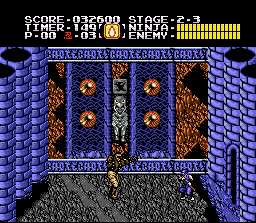 ... ...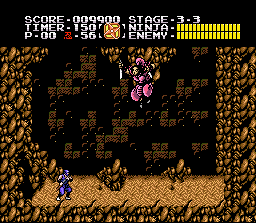
I don't understand why so many remakes for games turn out so terrible, especially when the remake is for a console that is more powerful than the one the game originally appeared on. Ninja Gaiden Trilogy, a Super NES compilation of the three NES Ninja Gaiden games, could be the poster child for bad ports. Although the games themselves remain fairly intact, attention to other details was slighted, and it dramatically alters the playing experience.
I was already aware that the graphical updates from the 8-bit versions were minor before I purchased NGT, so it doesn't bother me that they don't stand up to the best 16-bit efforts. What does bother me is how certain changes alter the atmosphere. Although some details in the stages themselves are more clear (it's nice that Ninja Gaiden is less "grainy"), the cinema scenes are too bright. The colors give the look of a child's storybook rather than reflect the dark tone of the storylines. Some scenes inexplicably flash, such as the one where you meet the Masked Devil. NG3, on the NES, had line-scrolling that created a parallax effect. It's gone on this version. (Why?? The Super NES is better-equipped to handle parallax scrolling than the NES.) The lightning has been removed from Level 3-1 of NG2, which not only causes a change in tone, but also diminishes most of the difficulty of that stage (though it may have been done for seizure risk reasons).
The music is so badly rendered on NGT that it can leave one scratching their head. All three games had great soundtracks, but you couldn't tell that from the trilogy. Perhaps it's no worry that the sound test codes are broken. Choice of instrumentation in some cases is highly questionable. It's almost sacreligious to see Ryu running through the Bazilisk Mine Field to the tune of a xylophone, but I'll admit that it made me laugh. All three games are missing their end credits sequences and music (they are programmed into the game, just left unused), but considering the quality, perhaps we should be grateful for that.
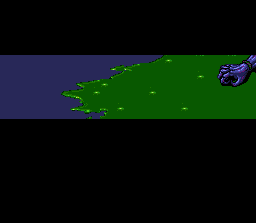 ... ...
The basic story lines for all three games have remained unchanged. One thing interesting about Ninja Gaiden is that its dialogue is uncensored. Ryu now has the line, "This is the hell that Malth was talking about", and Jaquio says, "Damn!" instead of "Argh!" at one point. This isn't much, but it's evidence of more wasted potential - potential for Ninja Gaiden Trilogy to give us the complete, uncensored Ninja Gaiden experience. So, then why on Earth was the blood censored in Ninja Gaiden II?? How is it possible that the NES version got away with having red blood, but it's now green on the Super NES version? Here its censorship is particularly perplexing because it's not even gratuitous blood (ie, Mortal Kombat), its presence is essential to the story. If I hadn't played the original, I may never have known that the giant green blob oozing across the floor was even supposed to be blood.
On top of all these disappointments, NGT has a laundry list of other problems: The game has numerous glitches and sometimes crashes. Some cutscenes are missing music, had their music changed, are missing animations, aren't timed correctly with the music, or cut off too soon. Of all things Tecmo did remain faithful to, the button-placement on the controller was not one that was necessary. But, yes, you actually use A to jump, and B to attack, rather than the standard B to jump and Y to attack, like in most other Super NES games. The A/B method is very awkward on a Super NES controller.
As bad as this port is, one reason I cannot give it a completely negative score is because the vital elements that made NG and NG2 great are still there. It would have taken much more effort to botch those up. Level 6 of Ninja Gaiden is still one of the most ingeniously-designed levels of any game, and it's here, intact and unedited in any way. I won't discuss the particulars of NG or NG2 here because I already did in my reviews for those games. (Look them up on the NES page if you are interested.) But I would like to discuss NG3, because I had not played it before and after playing it, and not enjoying it very much, I don't wish to play it again anytime soon.
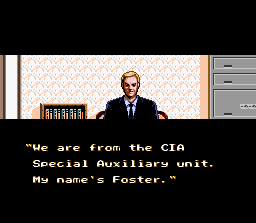 ... ...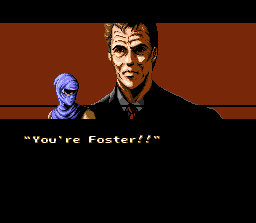
Foster, the slimy CIA agent from NG, reappears in NG3, but he looks as though he aged 40 years since then and isn't even the same person. His entire role here is to leap out of the shadows, laugh maniacally at Ryu, lord over a castle stronghold, and be killed unceremoniously in a scene with no suspense leading up to it. Foster did not seem like the kind of villain who should be doing any of those things.
Plot threads are introduced, only to be forgotten a moment later, such as the entire beginning setup which involves a mysterious laboratory full of bizarre life forms. You're immediately introduced to crazy concepts like subspace, trans-dimensional warships, bio-noids, and life energy, and they are presented as though they are self-explanatory. NG3 also has one of the worst cases of Plot Amnesia I've ever seen: Ryu is told to go to Castle Rock Fortress at the end of Act 1. He goes through a few levels, and at the end of Act 2, Foster appears and asks if the defenses surrounding Castle Rock were too much for him. Wouldn't that indicate that he has arrived at Castle Rock? But Ryu goes through several more stages and is welcomed to Castle Rock again by another character. He even appears to arrive at Castle Rock a third time after that.
I wasn't deterred by the purported difficulty of NG3. An even more challenging Ninja Gaiden game sounded intriguing. But it's not the difficulty that is the game's problem so much as why it is difficult. NG3's level design has a few new gimmicks, such as vertical scrolling, moving platforms, and grabbing overhangs. But even so, the levels feel strangely uninspired. They are slow, plodding, and in some cases, agonizingly too long. Those ideas may have been new to Ninja Gaiden, but they weren't new to video games in general, and they aren't utilized here in a way that's innovative. The timer is also extremely oppressive. Some stages seem impossible to beat in one life, even if you play perfectly, because the timer runs out halfway through.
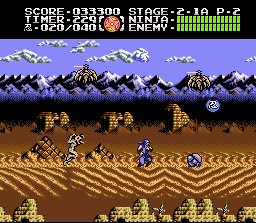 ... ...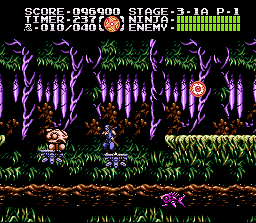
NG3's play control is very different from the previous installments. It is much slower and more "floaty", and I have a theory as to why: I think it's because of the vertical scrolling. In NG and NG2, when Ryu falls, he falls very fast. I'm guessing they didn't want him to fall that fast in areas with vertical scrolling. There are also some areas of this game where you have to fall from a high ledge, then tap the controller to move Ryu over a bit to land on a lower ledge. It wouldn't have been possible to do that with NG and NG2's play control. But it's not an excuse. The play control is so unintuitive for most situations, that it greatly detracts from the enjoyment of the game. I think the worst problem is when you grab a moving overhang, then try to flip up. Ryu flips up so slowly that (I'm not kidding), if you don't time it right the platform will move out from under him before he fully flips up and lands on it. There are also many vertical areas where it's necessary to go up a bit, then drop down to defeat enemies who appear below you, then start climbing up again. That gets tedious after awhile, especially in the final level, which just seems to go on forever.
NG3 was made easier than its NES counterpart. The NES game is notoriously difficult, and it had limited continues with no save feature. On NGT, the game has passwords and unlimited continues, making it a slightly less painful experience. If you couldn't beat NG3 on the NES (and you don't wish to utilize emulator save states), then NGT may be your one shot at doing it, and that is the only reason I can think of to recommend the trilogy.
But for NG and NG2, it's almost unbelievable how much better an experience they are on the NES. A part of me feels bad about having to give such a negative review, because the essential game elements are still intact, but the negligence to other important areas is unforgivable. And if we're not tough on botched ports, especially in cases where hardware inferiority is not an issue, that's a good way to ensure we'll see many more. With the possible exception of NG3, it's better to play the originals and skip this one.
Score: 2.5/5
|